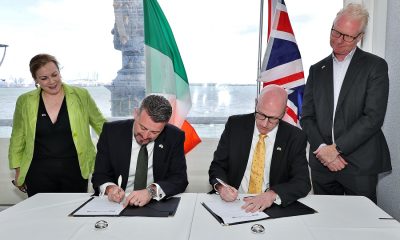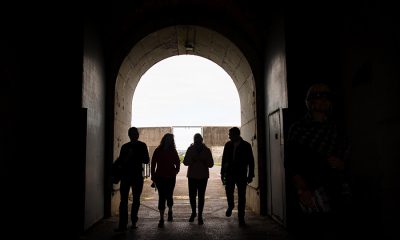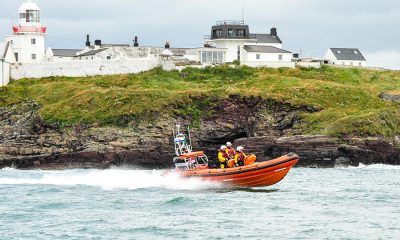Local News
103rd Lusitania anniversary to be remembered in Cobh
- Share
- Tweet /home/eastcork/public_html/wdir/wp-content/plugins/mvp-social-buttons/mvp-social-buttons.php on line 68
https://www.cobhedition.com/wdir/wp-content/uploads/2018/05/10987751_939765212712097_148488543972123332_n.jpg&description=103rd Lusitania anniversary to be remembered in Cobh', 'pinterestShare', 'width=750,height=350'); return false;" title="Pin This Post">
On Sunday 6th May 2018, the tragedy of the sinking of the Lusitania will be commemorated in Cobh. It is almost 103 years since the Lusitania slipped below the waves off the Old Head of Kinsale, just 18 minutes after being struck by a torpedo from a German U-boat.
The ceremony will commence in the Old Church Cemetery just outside the town at 3 pm. It is here that 170 of the 1200 who died were laid to rest. The ceremony of prayers, musical honours by the Commodore Choir and the laying of wreaths will also include the reading of the names of the victims by school children from Cobh.
Immediately afterwards the proceedings move to Cobh Town Centre. A Parade led by a Colour Party from the O.N.E. (Organisation of National Ex-Servicemen and Women) and other maritime and historical groups will leave from the Old Town Hall on Lynch’s Quay at approximately 3.40 pm to the Lusitania Peace Memorial in Casement Square.
Further ceremonies will take place here including a wreath laying ceremony.
Members of the public are encouraged to attend.
History of the Tragedy
On May 1, 1915, under the command of Captain William Turner the R.M.S. Lusitania left New York on her 202nd crossing of the Atlantic. The German government decided to warn passengers not to sail aboard Lusitania before this crossing. A prepaid warning advertisement was placed in fifty East Coast newspapers, including those in New York. This advertisement was to be put on the paper’s travel page a full week before the sailing date. However the advertisement only appeared in one newspaper, the Des Moines Register.
On May 7th, the Lusitania came into sight of the Irish coast. An Admiralty warning had been issued of submarine activity in the area. Captain Turner heeded this warning and put prudent precautions in place. Watertight doors were closed, double lookouts were posted, a black-out was ordered and the lifeboats were swung out on their davits so they could be quickly put into the water.On 7th May 1915 the Cunard liner Lusitania sank after being struck by a torpedo fired by the German Submarine U-20 off the old Head of Kinsale. Of the 1257 passengers and 702 crew on board, more than 1100 people died, including almost a hundred children. At around 13.45, the Lusitania was spotted by U-20. A torpedo was fired at 14.09. At 14.10, the German Commander Schwieger noted in his log that Lusitania was hit on the starboard side behind the bridge. A second explosion occurred soon after but the Germans insisted that only one torpedo was launched. The Lusitania started to list immediately and this list complicated the launch of her lifeboats. Of the forty eight lifeboats only six were successfully lowered. Just eighteen minutes later the Lusitania sank.
There was understandable anger throughout America and Great Britain at what was considered an act of brutality. 128 of the passengers and crew who drowned were American. Many consider the sinking of the Lusitania to be a contributing factor to the United States eventually entering the War.
Among those who died was renowned Irish art collector Sir Hugh Lane and millionaire Alfred Gwynne Vanderbilt. Most of the 764 people who were saved were landed in Cobh. Only 289 bodies were recovered and 170 of these were buried in the Old Church Cemetery in Cobh in three mass graves and 20 individual plots. Forty five of those buried were unidentified and their coffins were merely marked with a number.
-

 Announcements2 weeks ago
Announcements2 weeks agoJOB OPPORTUNITIES Watersedge Hotel are currently hiring for the following positions
-

 Local News3 weeks ago
Local News3 weeks agoLandmark Partnership: Cruise Ireland and Cruise Britain Join Forces to Boost Cruise Tourism
-

 Local News2 weeks ago
Local News2 weeks agoSpike Island’s After Dark Tours return: Explore the haunting history of iconic prison island once dubbed “Ireland’s Hell”
-

 Events & Entertainment2 weeks ago
Events & Entertainment2 weeks agoSarah Browne Exhibition at the Sirius Arts Centre
-

 Local News3 days ago
Local News3 days agoCrosshaven RNLI Assist Two on Disabled Yacht
-

 Local News3 days ago
Local News3 days agoCyclists of all abilities encouraged to join Fort2Fort Charity Cycle 2024Saturday, 8th June
-

 Announcements3 days ago
Announcements3 days agoCobh Youth & Social Projects CLG have the following vacancies
-

 Events & Entertainment3 days ago
Events & Entertainment3 days agoSIRIUS ARTS CENTRE: COMMISSION: Aikaterini Gegisian
-

 Sport2 days ago
Sport2 days agoJohn O’Shea extended as Interim Head Coach for June window
-

 Local Soccer2 weeks ago
Local Soccer2 weeks agoCobh Wanderers face College Corinthians in 1st Round of Sports Direct Men’s FAI Cup








